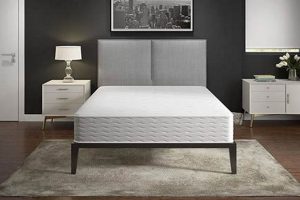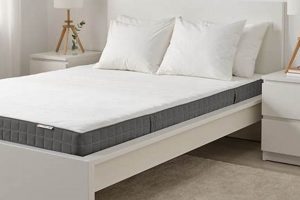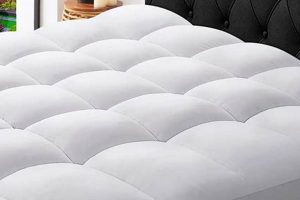A support surface designed to minimize pressure and shear forces on the skin, particularly over bony prominences, is crucial for individuals at risk of pressure injuries. Such surfaces address a critical need in healthcare and homecare settings, aiming to redistribute weight and promote circulation to prevent tissue breakdown.
The proper selection and utilization of these surfaces can significantly reduce the incidence and severity of pressure ulcers. Historically, prevention strategies have evolved from simple padding to sophisticated technologies incorporating alternating pressure, low air loss, and specialized foam. This evolution reflects a growing understanding of the biomechanical factors contributing to skin breakdown.
The ensuing discussion will examine the key features and types of support surfaces, focusing on their effectiveness in pressure injury prevention, along with considerations for patient needs and clinical implementation.
Guidance on Support Surface Selection
Selecting an appropriate support surface requires careful consideration of individual risk factors and specific clinical needs. The following recommendations offer guidance in optimizing surface selection for pressure injury prevention.
Tip 1: Risk Assessment is Paramount: Conduct a comprehensive risk assessment using a validated tool (e.g., Braden Scale) to determine the patient’s risk for pressure injury development. This assessment should guide the initial surface selection.
Tip 2: Consider Microclimate Management: Opt for surfaces that promote moisture wicking and airflow to minimize skin maceration. Microclimate control is especially important for individuals with incontinence or excessive perspiration.
Tip 3: Evaluate Immersion and Envelopment: Ensure the chosen surface allows for adequate immersion (sinking into the surface) and envelopment (surface conforming to the body’s contours) to redistribute pressure effectively.
Tip 4: Match Surface to Patient Weight: Select a surface rated to support the patient’s weight without bottoming out. Bottoming out negates the pressure-reducing benefits of the surface.
Tip 5: Consider Repositioning Needs: Understand that even the best surface requires consistent repositioning. Implement a regular repositioning schedule, at least every two hours, to further alleviate pressure.
Tip 6: Educate Caregivers: Provide thorough training to caregivers on the proper use, maintenance, and limitations of the chosen surface. This education should include techniques for positioning and transferring patients safely.
Tip 7: Regular Inspection and Maintenance: Regularly inspect the support surface for any signs of wear, damage, or malfunction. Promptly replace or repair compromised surfaces to maintain their effectiveness.
Adherence to these guidelines can enhance the effectiveness of support surfaces in mitigating pressure injury risk and promoting skin integrity.
The subsequent sections will delve into specific types of support surfaces and their application in diverse clinical scenarios.
1. Pressure Redistribution
Pressure redistribution is a fundamental component of support surfaces engineered for pressure injury prevention. Concentrated pressure, particularly over bony prominences, impedes blood flow to the tissues, leading to ischemia and subsequent tissue breakdown. A support surface capable of effectively redistributing this pressure diffuses the load across a larger area, reducing the pressure at any single point below the capillary closing pressure.
For example, a mattress employing alternating air cells cyclically inflates and deflates, shifting the points of contact and relieving pressure on vulnerable areas. Similarly, viscoelastic foam conforms to the body’s contours, increasing the contact area and thus lowering the pressure per unit area. A clinical scenario might involve a patient with limited mobility at high risk for sacral pressure injuries; in this case, a support surface with demonstrated pressure redistribution capabilities is critical. The practical significance lies in preventing the cascade of events leading to pressure ulcer formation, thereby reducing patient morbidity and healthcare costs.
In summary, effective pressure redistribution is a primary mechanism by which support surfaces mitigate the risk of pressure injuries. The selection of a mattress with validated pressure redistribution properties is essential for individuals at risk. While pressure redistribution is a key factor, other aspects such as microclimate management and shear reduction must be considered for optimal pressure injury prevention.
2. Microclimate Control
Microclimate control plays a vital role in pressure injury prevention. The microclimate, referring to the skin’s surface temperature and humidity, significantly influences skin integrity. Elevated moisture and temperature levels compromise the skin’s barrier function, increasing susceptibility to friction, shear, and subsequent breakdown. Effective microclimate management is thus integral to selecting a suitable support surface.
- Moisture Wicking Materials
Fabrics designed to wick moisture away from the skin, such as those incorporating synthetic fibers or specialized weaves, are essential. These materials facilitate evaporation, reducing humidity and preventing maceration. A clinical example involves an incontinent patient where a moisture wicking mattress helps maintain dry skin, reducing the risk of breakdown. This attribute directly impacts the choice of mattresses for individuals with moisture-related skin concerns.
- Air Permeability
The mattress’s ability to allow airflow is crucial for dissipating heat and moisture. Air-permeable materials or designs, such as those with open-cell foam or ventilation channels, promote circulation and regulate temperature. A patient experiencing night sweats benefits from a mattress with enhanced air permeability, keeping the skin cool and dry, thus reducing the risk of pressure injuries. This design consideration is key for patient comfort and skin health.
- Temperature Regulation
Some support surfaces incorporate temperature-regulating technologies, such as phase-change materials, to maintain a consistent and comfortable skin temperature. These materials absorb or release heat as needed, minimizing fluctuations that can compromise skin integrity. For instance, a patient with impaired thermoregulation benefits from a temperature-regulating mattress that keeps the skin from overheating or becoming too cold. This technology contributes to skin health by stabilizing the microclimate.
- Breathable Covers
The mattress cover is a critical component of microclimate control. Breathable covers, often m
ade of semi-permeable membranes, allow moisture vapor to escape while preventing fluid penetration. This creates a drier skin surface and reduces the risk of maceration. A patient confined to bed for extended periods benefits from a mattress with a breathable cover, which protects the skin from prolonged exposure to moisture and reduces pressure injury risk. The selection of a breathable cover enhances the overall effectiveness of the support surface.
The integration of moisture wicking, air permeability, temperature regulation, and breathable covers collectively contributes to effective microclimate control within a support surface. Prioritizing these features is crucial when selecting a mattress to minimize the risk of pressure injuries, particularly for individuals with compromised skin integrity or increased moisture exposure.
3. Support and Immersion
Support and immersion are fundamental biomechanical properties dictating the effectiveness of any support surface designed for pressure injury prevention. Support refers to the capacity of a mattress to bear weight without bottoming out, preventing direct pressure on bony prominences. Immersion describes the degree to which the body sinks into the support surface, increasing the contact area and reducing pressure concentration. A deficiency in either support or immersion compromises the pressure redistribution capabilities of the mattress, increasing the risk of tissue ischemia and ulceration.
An inadequate support system results in pressure being focused on areas such as the sacrum, heels, and ischial tuberosities. This can occur when the mattress is too thin, too firm, or unable to accommodate the patient’s weight. Conversely, insufficient immersion leads to a smaller contact area, concentrating pressure despite the mattress’s overall support capabilities. An individual with limited mobility and significant weight requires a mattress that offers both adequate support to prevent bottoming out and sufficient immersion to distribute weight evenly. Real-life examples include patients who develop pressure injuries despite being on specialized mattresses; this often indicates an imbalance between support and immersion, leading to persistent pressure on vulnerable areas. Thus, assessing both support and immersion is critical for selecting the best mattress for bed sores.
The practical significance of understanding support and immersion lies in its direct impact on patient outcomes. Mattresses that effectively balance these two properties contribute to improved tissue perfusion, reduced pain, and accelerated healing of existing pressure injuries. However, challenges remain in quantifying and tailoring these properties to individual patient needs, necessitating ongoing research and development in support surface technology. Overall, achieving the optimal balance of support and immersion is essential for maximizing the benefits of support surfaces in preventing and managing pressure injuries.
4. Durability & Maintenance
The durability and maintenance of a support surface are inextricably linked to its effectiveness in preventing pressure injuries. A mattress designed for pressure redistribution can only function optimally if its structural integrity remains intact over time. Degradation of materials, such as foam compression or air cell leakage, diminishes the mattress’s ability to redistribute pressure effectively, creating areas of concentrated force that can lead to tissue breakdown. Regular maintenance, including cleaning and inspection, is equally critical to prevent the accumulation of contaminants that can compromise hygiene and potentially damage the mattress’s components.
A clinical example illustrates this point: A high-risk patient is placed on a specialized air mattress. However, due to inadequate maintenance, the air cells gradually develop leaks, leading to uneven pressure distribution. Despite the initial intention of pressure relief, the compromised mattress now poses an elevated risk of pressure injury development. Furthermore, the material’s ability to maintain a hygienic environment directly impacts patient health. Damage to the mattress cover allows for the ingress of bodily fluids, creating a breeding ground for bacteria and increasing the risk of infection. Therefore, stringent maintenance protocols, including regular cleaning with appropriate disinfectants, are imperative. This consideration directly affects the total cost of ownership, necessitating a balance between initial investment and long-term maintenance requirements.
In summation, the long-term effectiveness of any support surface depends on its durability and adherence to a strict maintenance schedule. Selecting a robust, easy-to-maintain mattress is essential, but this must be coupled with comprehensive staff training on proper cleaning and inspection procedures. Neglecting these aspects undermines the initial investment in pressure injury prevention strategies and places patients at undue risk. The challenge lies in balancing cost-effectiveness with the need for durable, maintainable solutions that provide sustained pressure relief and maintain a hygienic patient environment.
5. Patient Specific Needs
The selection of an optimal support surface for pressure injury prevention necessitates meticulous consideration of individual patient characteristics. While generalized recommendations offer a foundation, tailoring the mattress to address unique physiological and environmental factors is paramount for effective pressure redistribution and microclimate management. Therefore, a nuanced understanding of patient-specific needs is essential in identifying a suitable mattress.
- Weight and Body Mass Distribution
A patient’s weight and body mass distribution significantly impact the support surface’s effectiveness. Individuals with higher body mass require mattresses with greater weight-bearing capacity to prevent bottoming out and ensure adequate pressure redistribution. Conversely, frail individuals with prominent bony landmarks may benefit from surfaces with enhanced immersion and envelopment capabilities. For example, a bariatric patient requires a mattress specifically designed to accommodate their weight and distribute pressure evenly across a larger surface area, while an elderly patient with thin skin may require a softer, more conforming surface.
- Mobility and Activity Level
Patient mobility influences the choice of support surface. Immobility or limited mobility increases the risk of sustained pressure on vulnerable areas. Individuals who are bedridden or chair-bound require mattresses with advanced pressure redistribution features, such as alternating air cells or low air loss technology. Active patients who can reposition themselves independently may benefit from simpler, static support surfaces that provide adequate pressure relief. Consider a patient recovering from surgery with limited mobility; an alternating pressure mattress is crucial to mitigate pressure buildup, in contrast to an ambulatory patient for whom a standard foam mattress may suffice.
- Skin Integrity and Existing Pressure Injuries
The p
resence of existing pressure injuries or compromised skin integrity dictates specific mattress requirements. Patients with open wounds require surfaces that promote wound healing by reducing pressure, managing moisture, and preventing shear forces. Low air loss mattresses can be beneficial in maintaining a dry wound environment and promoting circulation. Conversely, patients with intact but fragile skin require surfaces that minimize friction and shear. A patient with a Stage III pressure ulcer necessitates a mattress with advanced wound care features, whereas a patient with a history of skin tears needs a surface that is gentle and non-abrasive. - Comorbidities and Medical Conditions
Underlying medical conditions can significantly impact the selection of a mattress. Patients with incontinence require surfaces with fluid-resistant covers and effective moisture management properties. Individuals with respiratory or cardiac conditions may benefit from adjustable beds that allow for elevation and improved breathing. Furthermore, patients with neurological disorders may require mattresses that offer postural support and prevent sliding or shearing. A patient with diabetes and peripheral neuropathy needs a mattress that minimizes pressure on the extremities to prevent further tissue damage, compared to a patient with asthma who may benefit from an adjustable bed that facilitates breathing.
In summary, a comprehensive assessment of patient-specific needs is essential for selecting the optimal support surface for pressure injury prevention. Factors such as weight, mobility, skin integrity, and comorbidities must be carefully considered to ensure that the chosen mattress effectively redistributes pressure, manages microclimate, and promotes healing. Integrating these considerations into the mattress selection process optimizes patient outcomes and reduces the incidence of pressure injuries.
Frequently Asked Questions
The following section addresses common inquiries regarding the selection and use of support surfaces for pressure injury prevention.
Question 1: How frequently should support surfaces be cleaned and disinfected?
Support surfaces should be cleaned and disinfected according to the manufacturer’s instructions, typically after each patient use and routinely, such as daily or weekly, depending on the care setting and level of soiling. Prompt cleaning is essential following any contamination with blood, urine, or other bodily fluids.
Question 2: Can a support surface completely eliminate the need for repositioning?
No, support surfaces are intended to augment, not replace, regular repositioning. Repositioning remains a critical component of pressure injury prevention protocols, typically every two hours, to relieve pressure and promote circulation to all areas of the body.
Question 3: Are more expensive support surfaces always superior?
Cost does not always correlate with effectiveness. The optimal support surface depends on individual patient risk factors, clinical needs, and the surface’s ability to redistribute pressure, manage microclimate, and provide adequate support. A comprehensive assessment is necessary to determine the most appropriate option.
Question 4: How should support surfaces be evaluated for damage or wear?
Support surfaces should be routinely inspected for signs of wear, tears, punctures, or deflation. Air mattresses should be checked for leaks. Foam mattresses should be examined for compression or deformation. Any compromised surface should be repaired or replaced immediately to maintain its effectiveness.
Question 5: What factors should be considered when selecting a support surface for a bariatric patient?
For bariatric patients, it is critical to select a support surface with an appropriate weight capacity rating to prevent bottoming out. The surface should also provide adequate width and length to accommodate the patient’s size. Furthermore, microclimate management features are essential to address increased perspiration levels.
Question 6: Is specialized training required for caregivers to properly use and maintain support surfaces?
Yes, caregivers should receive comprehensive training on the proper use, maintenance, and limitations of the chosen support surface. Training should include techniques for positioning and transferring patients safely, as well as protocols for cleaning, disinfection, and inspection.
In summary, selecting and utilizing support surfaces effectively requires a thorough understanding of patient-specific needs, surface characteristics, and proper maintenance protocols. Prioritizing these factors optimizes patient outcomes and reduces the incidence of pressure injuries.
The subsequent sections will address emerging trends in support surface technology and future directions in pressure injury prevention.
Conclusion
The preceding discussion has illuminated the critical factors involved in selecting the best mattress for bed sores. A comprehensive approach, encompassing pressure redistribution, microclimate control, adequate support, durability, and patient-specific needs, is paramount. The inappropriate selection or inadequate maintenance of a support surface can negate its intended benefits, potentially exacerbating pressure injury risk.
Moving forward, continued research and technological advancements in support surface design hold the promise of further reducing the incidence and severity of pressure injuries. Diligence in implementing evidence-based practices, coupled with ongoing education for caregivers, remains essential to ensure optimal patient outcomes and a sustained reduction in the burden of pressure ulcers on healthcare systems.





![Top Rated Best Mattress For Night Sweats - [Brand Name] Organic & Natural Mattress Buyer’s Guide: Non-Toxic Sleep Solutions Top Rated Best Mattress For Night Sweats - [Brand Name] | Organic & Natural Mattress Buyer’s Guide: Non-Toxic Sleep Solutions](https://mattressworldpa.com/wp-content/uploads/2025/07/th-7601-300x200.jpg)

![Top-Rated Best Mattress for Adjustable Base Frames [Guide] Organic & Natural Mattress Buyer’s Guide: Non-Toxic Sleep Solutions Top-Rated Best Mattress for Adjustable Base Frames [Guide] | Organic & Natural Mattress Buyer’s Guide: Non-Toxic Sleep Solutions](https://mattressworldpa.com/wp-content/uploads/2025/07/th-7599-300x200.jpg)